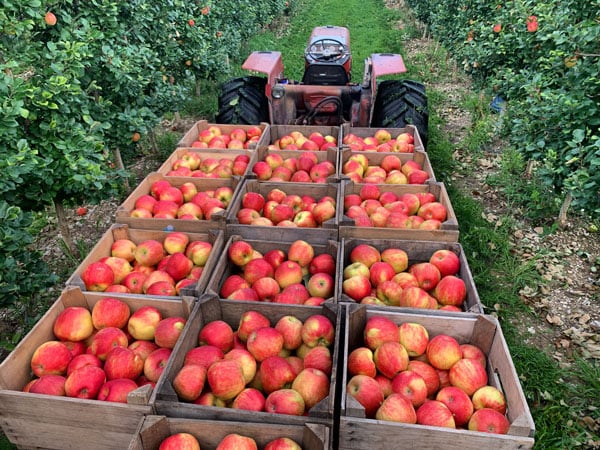Deficit Irrigation in Apples to Control Sizing and Bitter Pit
Sizing and bitter pit continue to be the greatest challenges of growing Honeycrisp apples and can be a major culprit in reducing returns of a perfectly grown crop.
In this blog post, we'll cover what goes on in the fruit during the apple sizing process and how you can develop a deficit irrigation strategy to optimize fruit size and reduce the rates of bitter pit.

The tremendously large, cider-sweet fruit that Honeycrisp apple trees produce seemed like the holy grail of apples when they first arrived on the commercial market. However, the exceptional size didn’t match the consumer’s desire for single-serving sized fruits and practices to reduce the size of the apple only confounded the apple’s already voracious desire for calcium—increasing incidences of bitter pit, and limiting supply.
The science behind the apple sizing process
Even though fruits continue to grow in size through most of the season, they only develop new cells within a short period of time around bloom. The sizing of the apple occurs due to the enlargement of those cells.
A bite of an undeveloped apple will lack the crisp crack and smack that we are used to and instead yield a dense, spongy feel. That is because the cells have not yet increased in size to the point that they contain the expected amount of water and sugars.
Cell enlargement process
At night, when leaf stomata close, water continues to enter the plants due to osmotic pressure. Because stomata are closed, water has nowhere to go and pressure builds within the plant. As pressure builds, the cell walls of immature cells in the tree loosen and expand like a balloon from the pressure.
By the time sunlight reaches the leaves in the morning, the cell walls once again lock down and hold their now slightly larger size until night comes again. This process continues for as long as the cells remain immature.
How to control for fruit size and bitter pit
The amount a cell can grow during a night depends on how much water was in the tree when it “went to sleep”. If the tree has plenty of water, it isn’t hard for pressure to build at night and for the cells to expand considerably.
On the other hand, if the tree lacks water upon nightfall, it takes much longer to build pressure and the pressure will not be as high, resulting in cells that do not expand as much as a tree with plenty of water.
This is how we limit fruit size: ensure that there is enough stress each day that the trees cannot build as much pressure and enlarge the cells as much.
As much as I wish we had exact numbers to guide these irrigation management decisions, we do not yet have the exact parameters to suit trees in every soil and condition. But, the principle of the practice can guide us, and monitoring soil moisture levels can help ensure that we hold back water and limit the size of the fruit upon ripening.
Using soil moisture monitoring tools
As the trees begin to sense a shortage of water, they respond by reducing the size of the pores in their leaves, or the stomata, where water exits the plant. This results in a decrease in the rate of their water consumption.
In order to reduce the amount of growth the apples put on each night, we want to bring them down to where they are sensing and responding to stress. That point varies from soil to soil, but we can see the change in trend in the data below.
-Aug-16-2023-03-17-50-0108-PM.png?width=600&height=275&name=image%20(1)-Aug-16-2023-03-17-50-0108-PM.png)
An example of a site's available water content readings from the Semios water management tools
In this graph, you can see that the rate the soil moisture is being drawn down changes at around 65%. That is the point at which the tree is beginning to struggle to pull water from the soil and is the point where you want to take the trees to in order to reduce the size of the fruit.
As we get more data, we will be able to better recommend where deficit occurs, in the meantime, you can experiment with your irrigation management and begin to learn your soils better and see what brings the best results for you.



